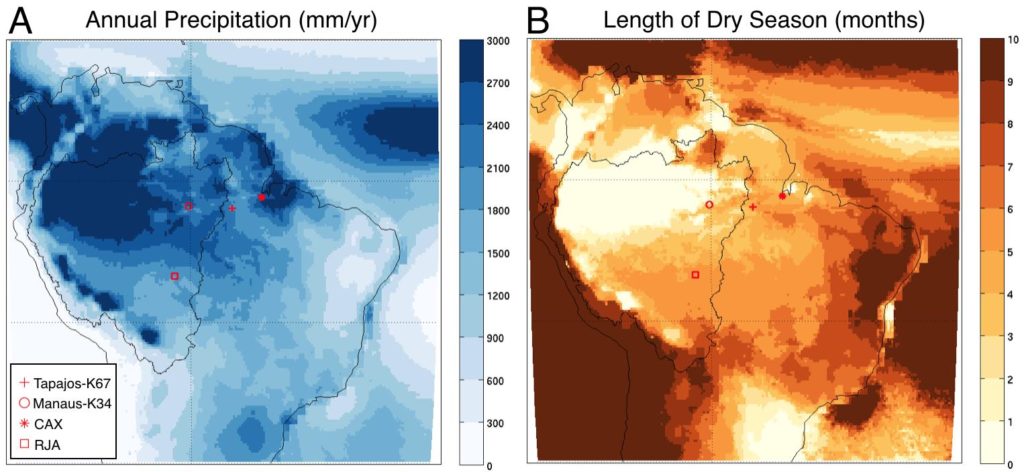Researchers estimate evapotranspiration for the Amazon basin using a water budget approach and show complex seasonal cycle and long-term changes in forest function.
The Science
We combined satellite measurements of rainfall and gravity anomalies with Amazon river flow data to derive a seasonally-resolved estimate of evapotranspiration for the entire Amazon basin. We then analyze the seasonal cycles and long-term variation of this measurement, and compare it to process-based land surface model predictions.
The Impact
The results show a more complex and different seasonal cycle than current land surface models predict. They also suggest a long-term decline in evapotranspiration from the forest, due to ecosystem functional change at the scale of the entire basin.
 Figure 1. Maps showing (A) the annual mean precipitation in mm/yr, and (B) the length of the dry season in months where blue colors indicate wetter conditions and red and brown colors indicated drier conditions. An outline of the basin used in this analysis—the Amazon basin upstream of the gauging station at Óbidos—is shown in the black outline. Red markers indicate the location of four flux towers near the region from Wu et al. (2016).
Figure 1. Maps showing (A) the annual mean precipitation in mm/yr, and (B) the length of the dry season in months where blue colors indicate wetter conditions and red and brown colors indicated drier conditions. An outline of the basin used in this analysis—the Amazon basin upstream of the gauging station at Óbidos—is shown in the black outline. Red markers indicate the location of four flux towers near the region from Wu et al. (2016).
Summary
Evapotranspiration, which comprises the sum of all moisture fluxes from an ecosystem directly to the atmosphere, is a crucial quantity at the center of the terrestrial energy, water, and carbon cycles. Because measurements of evapotranspiration are typically made at local scales, and are sparse over remote locations such as the Amazon, the larger-scale fluxes are not well known. We combined observations of rainfall, river discharge, and time-varying gravity anomalies to construct a water budget for the Amazon basin, which allows us to solve for evapotranspiration as the missing term in the budget. This water budget-based measurement shows a complex seasonal cycle, with a deeper minimum during the wet season than is estimated by other upscaling estimates or by process-based models, and also shows that models tend to increase their seasonal evapotranspiration fluxes later in the dry season than is observed. Furthermore, a long-term analysis of evapotranspiration suggests a decline in the rate over the period of observation, which could be evidence of a large-scale change in ecosystem function.
Contacts (BER PM): Daniel Stover, Dorothy Koch, Renu Joseph, SC-23.1, Daniel.Stover@science.doe.gov (301-903-0289), dorothy.koch@science.doe.gov (301-903-0105), Renu.Joseph@science.doe.gov (301-903-9237)
PI Contact: Charles Koven, Lawrence Berkeley National Lab, cdkoven@lbl.gov, 510.486.6724
Funding
ALSS was supported by National Science Foundation grants AGS-1321745 and AGS-1553715. CDK received support from the Regional and Global Climate Modeling program through the BGC-Feedbacks SFA and the Terrestrial Ecosystem Sciences and Earth System Modeling programs through the Next Generation Ecosystem Experiments-Tropics (NGEE-Tropics) project of the Biological and Environmental Research (BER) Program in the U. S. Dept. of Energy Office of Science.
Publications
Swann, A. L. S., and Koven , C. D. A direct estimate of the seasonal cycle of evapotranspiration over the Amazon. Journal of Hydrometeorology (2017) doi:10.1175/JHM-D-17-0004.1
Related Links
http://journals.ametsoc.org/doi/10.1175/JHM-D-17-0004.1